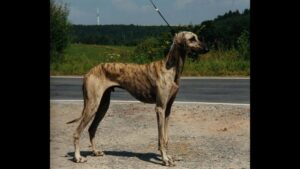
The Sloughi: Ancient Hound of North Africa
Discover the ancient Sloughi – North Africa’s elegant coursing hound, bred for hunting and known for its loyalty and grace.
Home » Meet The Breeds » Sloughi
The Sloughi, often referred to as the “Arabian Greyhound,” is a rare and ancient purebred dog known for its elegance, grace, and strong hunting capabilities. Originating from North Africa, particularly in the regions encompassing Morocco, Algeria, Tunisia, and Libya, this sighthound was treasured by Berber and Bedouin tribes for its prowess in hunting game across the open desert. The breed is characterized by its robust yet elegant appearance and its deep-rooted loyalty, making it both an efficient hunter and a cherished companion.
Hound
24 – 29 Inches
35 – 50 Pounds
10 – 15 Years
| Country of Origin | Morocco, Algeria, Tunisia, Libya |
|---|---|
| Bred For | Hunting a Variety of Game, Companionship |
| Known For | Ancient Origin, Hunting Skills, Stubbornness |
| Popularity | Low |
| Temperament | Aloof, Graceful, Noble |
| Activities | Coursing, Running, Hiking, Conformation Shows, Dog Sports |
The Sloughi, also known as the Arabian Greyhound, boasts a rich and storied history, with roots stretching deeply in North Africa. Originally bred by the Berber and Bedouin peoples, this sighthound was highly prized for its exceptional hunting abilities, particularly for its speed and agility in chasing down game over vast and rugged terrain. The breed was used primarily to hunt hare, foxes, and jackals, a skill set that showcases both its versatility and its endurance.
As the Sloughi spread across Morocco, Algeria, Tunisia, and Libya, it became a part of local cultures and was regarded with great esteem by many. The hound was more than just a hunting companion; it was a cherished member of the family, and its welfare and purity of breed were taken very seriously.
The Sloughi’s journey to the Western world began in the late 19th and early 20th centuries, although it remained relatively rare outside its native lands. The breed’s elegant appearance and noble bearing caught the attention of dog enthusiasts, leading to its gradual introduction to Europe, and subsequently, the United States.
The breed’s acknowledgement by major kennel organizations marked a pivotal chapter in Sloughi’s storied history. The Fédération Cynologique Internationale (FCI) led the way with official recognition in 1998, setting the stage for global acknowledgment. Years later, the American Kennel Club (AKC) followed suit, welcoming the Sloughi to the Hound Group in 2016.
Throughout its long history, the Sloughi has maintained its dignified nature, hunting prowess, and striking appearance. Today, while these hounds are cherished as companions and show dogs, their rich heritage as a skilled hunter continues to be a defining aspect of breed identity. As interest in the Sloughi grows, efforts to protect and preserve the breed globally continue, ensuring its legacy for future generations.
Adult male Sloughis typically stand between 26 and 29 inches tall at the shoulder, while mature females typically range from 24 to 27 inches tall.
In terms of weight, males can weigh between 55 and 65 pounds, with females averaging 45 to 50 pounds.
The Sloughi is powerfully built and well-proportioned, ensuring both efficient movement and agility. This sighthound’s height at the withers is slightly taller than its length, measured from the point of shoulder to the point of the buttocks. Its substance is athletic, with pronounced muscles that are evident but not overly bulky. The body and legs are rather bony, with lean muscles that suggest both power and elegance, and a deep chest that is indicative of the breed’s strong cardiovascular system, vital for endurance when pursuing fast-moving prey.
Texture: The ancient Sloughi is a very “natural” dog. Its coat reflects its heritage as a swift and agile sighthound, one that is streamlined for speed and efficiency. The coat is short, fine, and smooth to the touch, lying close to the body. Hair that is not tight and smooth, and any feathering on the ears, tail, and/or legs, is unacceptable in this swift and sinewy sighthound.
| Standard Color | |
|---|---|
| Sandy | ee |
| Cream | ee |
| Mahogany | ee |
| Red | ee |
| Standard Marking | |
|---|---|
| Black Mask | ee |
| Darker Overlay | ee |
| Mantle | ee |
| Brindle | ee |
| Black Brindle | ee |
| Brindle Black Mask | ee |
| Brindle Black Mantle | ee |
A Note About Color: Color in the breed ranges from light sand (cream) to mahogany red fawn, with or without black markings and/or brindling. Black markings can appear as a black mask, black ears, and/or a black mantle (black and sand or black and brindle). A dark overlay is also acceptable, as is a small white mark on the chest and/or small white marks on the toes. White anywhere else on the body (other than white hairs caused by aging or scars), and any other color, is unacceptable in the breed.
The tail is set in line with the croup, emerging as a natural extension of the topline. It is long and carried at or below the level of its insertion. The end of the tail may curve slightly upwards when the dog is in motion or excited. When at rest, it hangs down, reaching the hocks and displaying an upward curve or small ring at the tip.
The tail’s appearance and carriage are indicative of the Sloughi’s mood and energy levels, providing insight into its emotional state. The tail’s natural carriage contributes to the breed’s distinctive and captivating presence, both in the show ring and as a beloved companion.
The tail of the Sloughi is an essential aspect of the breed and is never docked. In motion, its gentle curve and horizontal carriage enhance the breed’s elegance and grace, and they suggest its tremendous agility and speed. The tail plays a significant role in the overall balance and movement of the breed, reflecting its sighthound heritage and history as an agile desert hunter.
The Sloughi, with its regal appearance and dignified demeanor, is a breed that commands admiration. However, prospective owners should consider several factors to foster a harmonious relationship and a healthy, happy life for the dog.
The Sloughi is generally a healthy breed, but as with all dogs, it may be prone to certain health conditions. The breed’s lean build and short coat make these hounds more susceptible to extreme weather conditions, so appropriate shelter and care are necessary for their well-being.
Lifespan: The Sloughi has an average lifespan of 10-15 years, which is relatively long for a breed of its size.
While the Sloughi is a robust breed with a generally healthy constitution, like any breed or mixed breed, individuals can be susceptible to certain health conditions. Prospective owners should be aware of these risks to ensure they are well-prepared to provide the necessary care and attention.
Some of the health conditions that have been observed in the Sloughi include:
To safeguard the health of a Sloughi, it is crucial for owners to have a good relationship with their dogs’ breeders and to maintain regular veterinary check-ups. These exams allow for early detection and intervention, increasing the likelihood of successful management through treatment options.
The Sloughi boasts a temperament that is as dignified as is the sighthound’s appearance, marked by a gentle and affectionate nature towards its family. This breed forms a profound bond with its human companions, showcasing its indisputable loyalty and unwavering devotion. These hounds tend to be reserved at times, yet they are not aloof with family members, often seeking out attention and companionship instead.
When it comes to living with other dogs, the Sloughi can coexist peacefully, especially if the dogs are raised together from a young age. However, the breed’s strong prey drive can pose challenges when interacting with smaller pets or unfamiliar animals. Caution, and proper introductions, are necessary to ensure harmonious interactions.
The breed’s relationship with young children requires supervision and guidance. While Sloughis can be gentle, their sensitive nature means they may not tolerate rough play or sudden movements. It is therefore important to educate kids on how to be respectful of a Sloughi that is being asked to interact with them.
Sloughis can be often reserved around strangers, displaying a cautious, but not fearful, demeanor. Early socialization is crucial to help these dogs become well-adjusted and confident as adults. Exposing them to various people, places, and situations from a young age can aid in developing their social skills.
Despite the breed’s reserved nature, the Sloughi is not typically prone to separation anxiety. However, these dogs do value the company of their family and thrive in an environment where they are included in daily activities. Including the Sloughi in family outings can be vital for the emotional well-being of this athletic and elegant sighthound.
Feeding a Sloughi requires attention to their specific nutritional needs to ensure they maintain their lean and athletic physique. Adult Sloughis typically do well on a high-quality commercial or homemade diet that is appropriately balanced and approved by a veterinarian. When choosing a commercial dog food, look for brands that list a high-quality source of protein, such as chicken or beef, as the first ingredient.
Puppies have different nutritional requirements compared to adult dogs. A Sloughi puppy should be fed puppy formula food, which ensures they are receiving the necessary nutrients for proper growth and development. It is crucial to follow the feeding guide on the dog food packaging or seek advice from a veterinarian to determine the correct portion size for the puppy’s age and weight.
Adult Sloughis generally require about 2 to 3 cups of dry dog food per day, divided into two meals. The exact amount can vary depending on the dog’s age, activity level, and metabolism. Active Sloughis or those involved in canine sports may require additional calories to support their energy needs, while older or less active dogs may require fewer calories to prevent weight gain.
Consistency in feeding routines and portion control is key to maintaining their optimal health. Overfeeding can lead to obesity, which can contribute to various health issues, including joint problems and decreased lifespan. Providing fresh water at all times and monitoring the dog’s body condition and adjusting food portions as necessary are also important aspects of proper nutrition.
Training a Sloughi necessitates a thoughtful approach, as these dogs respond best to positive reinforcement and patient, consistent guidance. They possess a notable level of intelligence, making them capable learners, yet their independent nature may sometimes present challenges in training. Thus, establishing a trusting relationship and employing motivational techniques are imperative.
The breed’s sensitivity requires a gentle training method, as they may not respond well to harsh corrections or negative reinforcement. Positive rewards such as treats, praise, and play can enhance their learning experience and strengthen the bond between the dog and the trainer. Starting training from a young age and providing ongoing socialization can significantly contribute to a well-behaved and adaptable adult dog.
In terms of their vocalization, Sloughis are not known to be excessively barky. They may bark to alert their owners of something unusual, but they generally do not engage in unnecessary barking. Ensuring they are mentally stimulated and have adequate exercise can further reduce any tendency to bark out of boredom or anxiety.
Their prey drive is a notable aspect of their temperament, and this instinctive trait may lead them to chase after smaller animals or moving objects. Training them to have a reliable recall and providing them with a secure, enclosed space for off-leash activities can help manage this prey drive. However, care should always be taken when they are in areas with potential distractions or hazards.
The potential for wanderlust in Sloughis is present, yet it can be mitigated through training and ensuring their environment is secure. They may have a desire to explore and may not always be inclined to stay within boundaries if something catches their interest. Therefore, reinforcing recall commands and providing adequate physical and mental stimulation are crucial.
The Sloughi, with its lean and athletic build, requires a substantial amount of exercise to maintain optimal health and well-being. This breed is characterized by a high energy level and an inherent desire to run, stemming from its historical use as a hunting and coursing dog. Ensuring that a Sloughi receives adequate exercise is paramount to preventing boredom and associated behavioral issues.
| Energy Level | Medium-High |
|---|---|
| Exercise Requirements | 2 Hours/Day (Minimum), Daily Walks, Vigorous Running, Regular Exercise, Playing with Another Dog, Mental Stimulation |
The exercise regimen should include a combination of physical activities and mental stimulation. Activities such as running, playing fetch, and engaging in canine sports can help to channel their energy positively. Interactive toys and puzzle feeders can also provide mental challenges, keeping their minds active and engaged.
Despite their high energy levels, Sloughis also have a calm and gentle side, particularly when they are indoors. They enjoy being part of family activities and will often seek out affection and companionship from their human family members. However, they do require a chance to expend their energy through vigorous exercise each day.
Playfulness is a characteristic trait of the Sloughi, and they often enjoy engaging in play with their human companions or canine friends. Providing opportunities for play in a secure, enclosed area can allow them to express this playful nature while ensuring their safety.
The intensity of the exercise should be matched to their age, health status, and individual energy levels. Puppies and young adults may have bursts of energy and require more frequent play sessions, while older Sloughis may prefer longer, steadier forms of exercise.
Grooming a Sloughi is generally considered a straightforward task due to their short, fine coat. This breed is not known for having a heavy shedding pattern, which further contributes to the ease of their grooming regimen. Regular brushing, however, is essential to help distribute natural oils, remove any loose hairs, and keep their coat looking sleek and shiny.
| Coat Type | Short, Tight, Fine |
|---|---|
| Grooming Requirements | Weekly Brushing, Occasional Bathing, Routine Ear Cleaning, Periodic Nail Trimming, Regular Tooth Brushing |
The coat benefits from a weekly brushing session using a soft bristle brush or a hound mitt. This not only aids in maintaining the coat’s natural luster but also provides an opportunity to check for any signs of skin issues, parasites, or injuries. Their ears should also be checked regularly and cleaned as necessary to prevent infections.
In addition to coat care, their nails should be trimmed regularly to prevent overgrowth and the associated discomfort. Dental hygiene is another crucial aspect of their grooming routine, and incorporating teeth brushing or providing dental chews can help in maintaining good oral health.
Despite their short coat, Sloughis can occasionally experience seasonal shedding, during which increased brushing can help manage loose hairs and keep their coat in top condition. Bathing the Sloughi can be done as needed, and using a dog-specific shampoo will help in preserving the natural oils in their skin and coat.
Accommodating a Sloughi in one’s home requires consideration of their unique characteristics and needs. These elegant sighthounds possess a calm and gentle demeanor indoors, making them well-suited to various living situations, including apartment living, as long as their exercise needs are adequately met. Ensuring they have access to ample space for stretching and playing is vital, particularly if living in a smaller space.
In terms of weather adaptability, Sloughis have a short coat and lean physique, which makes them more sensitive to extreme weather conditions. During colder months, providing them with appropriate dog clothing or ensuring they have a warm space indoors is essential. In contrast, they can tolerate warmer climates but should always have access to shade and fresh water, and outdoor activities should be limited during the hottest parts of the day to prevent overheating.
The Sloughi appreciates being part of family activities and enjoys the companionship of their human family members. They form strong bonds with their owners, and providing them with attention and affection contributes to their overall well-being. They thrive in environments where they are considered a part of the family and can participate in daily activities.
The arrival of a litter of Sloughi puppies is a genuine cause for celebration. It is, however, important to be well-prepared and informed about the unique needs and characteristics of this breed. Sloughi puppies are energetic, and intelligent, and they require early socialization and training to ensure they grow up to become well-mannered and balanced adults.
Caring for a Sloughi puppy demands attentiveness and understanding of the breed’s specific requirements. Socialization should begin early by introducing the puppy to a variety of people, environments, and other dogs. This helps in developing its confidence and supports its overall comfort level in the modern world.
Training should begin at the puppy stage, with a focus on positive reinforcement techniques. The Sloughi puppy is intelligent and responds well to training that is consistent and patient. Establishing clear boundaries and rules is also essential to prevent any behavioral issues in the future.
The Sloughi puppy needs a balanced diet that is suitable for the pup’s age, size, and activity level. Regular veterinary check-ups are crucial to monitor its growth and overall health, as is keeping up with a vaccination schedule.
Providing ample opportunities for play and exercise are important, as the Sloughi puppy is energetic and requires sufficient physical activity to burn off excess energy. However, it is essential to be mindful of the little one’s growing joints and avoid excessive exercise that could potentially cause harm.
Creating a safe and nurturing environment for the Sloughi puppy is paramount. With proper care, socialization, and training, the pup will grow up to become a loyal, graceful, and affectionate companion.
The Sloughi, a breed known for its elegance and agility, thrives when engaged in various activities. Participation in these events not only fulfills the hound’s physical needs, it also provides the mental stimulation that contributes positively to its overall well-being. Some of the dog sports that are suitable for the breed include:
By participating in these activities and dog sports, Sloughis not only stay physically fit but also enjoy mental stimulation. It enhances their quality of life, strengthens the bond with their handlers, and showcases the breed’s versatility and capability in various canine disciplines.
The Sloughi is recognized by the world’s leading registries and kennel organizations, which categorize the breed into a specific Group based on its unique characteristics. This breed is recognized worldwide under the following Group designations:
| Organization | Group Classification |
|---|---|
| AKC (American Kennel Club) | Hound |
| UKC (United Kennel Club) | Sighthound and Pariah Dog |
| CKC (Canadian Kennel Club) | Not Recognized |
| ANKC (Australian National Kennel Council) | Hounds |
| RKC (The Royal Kennel Club) | Hound |
| FCI (Fédération Cynologique Internationale) | Group 10: Sighthounds; Section 3: Short-Haired Sighthounds |
The ideal Sloughi is described by a Breed Standard that is approved by each of the world’s leading registries and kennel organizations. The Breed Standards for this breed may be found in the following links:
| Organization | Breed Standard |
|---|---|
| American Kennel Club | AKC Sloughi Breed Standard |
| United Kennel Club | UKC Sloughi Breed Standard |
| Canadian Kennel Club | Not Recognized |
| Australian National Kennel Council | ANKC Sloughi Breed Standard |
| The Royal Kennel Club | RKC Sloughi Breed Standard |
| Fédération Cynologique Internationale | FCI Sloughi Breed Standard |
Sloughi Clubs play an essential role in the preservation, promotion, and understanding of this unique breed. These clubs provide valuable resources for owners, breeders, and enthusiasts, fostering a sense of community and shared knowledge.
In the United States, the American Sloughi Association stands as a pivotal organization for those interested in the breed. It works tirelessly to protect and advance the interests of the breed, providing educational materials, hosting events, and advocating for responsible breeding practices.
The Sloughi Club serves as a resource and community for Sloughi owners and enthusiasts in the United Kingdom. It works in tandem with The Kennel Club (UK) to uphold the breed’s standards and promote responsible ownership.
These clubs collectively contribute to the global network of Sloughi support, ensuring that the breed receives the attention and care it deserves. They facilitate a space for sharing knowledge, experience, and passion for the Sloughi, playing a crucial role in the breed’s preservation for future generations.
The role of Sloughi rescue groups is indispensable in safeguarding the wellbeing of this breed, ensuring that these dogs find loving and suitable homes. While the Sloughi is a relatively rare breed, particularly outside its native North Africa, there are dedicated individuals and organizations working tirelessly to support them.
In the United States, there are breed-specific rescue groups such as Sloughi Rescue, which focuses solely on helping Sloughis in need. They work to rehabilitate and rehome Sloughis, providing a safety net for these graceful dogs. Additionally, national breed clubs often have rescue coordinators and resources to assist Sloughis in need.
In the United Kingdom, sighthound-specific rescue groups also extend their help to Sloughis, providing a crucial service in ensuring the breed’s welfare.
Even if breed-specific rescue groups are not available in certain regions, local shelters and general dog rescue organizations might have Sloughis or Sloughi mixes in need of homes. Potential adopters are encouraged to reach out to these establishments, as they can serve as valuable resources in connecting adopters with Sloughis in need of a second chance.
The Sloughi possesses a mystique and an elegance that captures the attention of many, making it a breed rich with interesting facts and trivia.
The Sloughi can make a good family dog, particularly if raised with children from a young age. The breed is known for its gentle and affectionate nature towards family members, creating strong bonds. However, due to the sensitive nature of these hounds, it is crucial to teach children how to interact respectfully and gently with a Sloughi, as rough play could make the dog uncomfortable.
While the Sloughi is intelligent and has the potential to be trained for various tasks, it is not commonly used as a Service Dog. The breed’s sensitive nature and need for companionship can make it challenging for these dogs to work in high-stress or overly stimulating environments. However, with proper training, an individual Sloughi might be suitable for certain types of service work, particularly if it forms a strong bond with its handler.
The Sloughi is an excellent hunting dog, with a strong prey drive and exceptional agility and speed. Originally bred for hunting game in the harsh environments of North Africa, the breed is well-equipped to chase and catch prey over vast distances. However, it is important to note that in a modern, non-hunting family setting, the breed’s prey drive could be directed towards smaller pets or wildlife, so careful management and training are required.
The Sloughi is a breed that forms strong attachments to its family and can struggle with being left alone for extended periods. These dogs may become anxious or exhibit destructive behaviors when left alone all day. It is recommended for Sloughi owners to arrange for company, whether it be human or another pet, or to provide interactive toys and activities to keep the dog engaged when it is left alone for any length of time.
In terms of grooming, the Sloughi is considered a low-maintenance breed due to its short coat. However, these hounds do require regular exercise to keep them physically and mentally stimulated, as well as consistent training and socialization. Additionally, their sensitive nature means they need a calm, stable environment and plenty of attention and affection from their families.
The Sloughi is not known to be a particularly vocal breed, and these dogs typically do not bark excessively. However, like all dogs, individual Sloughis may vary in their vocal behavior, and some may be more prone to barking than others. Proper training and socialization from a young age can help to manage and minimize unnecessary barking.
The Sloughi has a short coat, and while all dogs shed to some extent, the amount of shedding for this breed is generally considered to be low. Regular brushing can help to keep shedding under control and also serves as an opportunity to check for any skin issues or parasites. Maintaining a healthy diet and ensuring the Sloughi is in good overall health can also contribute to minimizing shedding.

Discover the ancient Sloughi – North Africa’s elegant coursing hound, bred for hunting and known for its loyalty and grace.
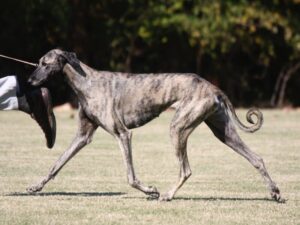
Master the art of judging the Sloughi dog breed. Learn about the breed’s history, conformation standards, body proportions, and more.
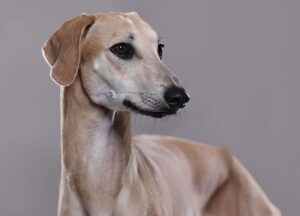
The Sloughi or Arabian Greyhound, is an ancient sighthound dog breed originating in North Africa, developed to hunt a wide variety of game.

Breeder Nancy Lovelady shares her passion for Sloughis, breeding ethics, and preserving elegant, functional hounds.
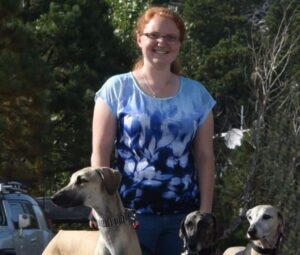
Anna Pierson is the breeder behind Sloughis du Soleil. Read about the kennel’s beginnings, the sires, the dams, the puppies, and more!
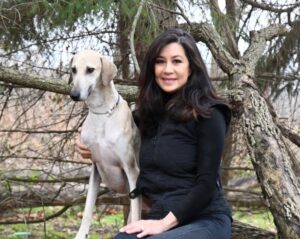
Erika Wyatt is the breeder behind Ocerico Sloughis. Read about the kennel’s beginnings, the sires, the dams, the puppies, and more!
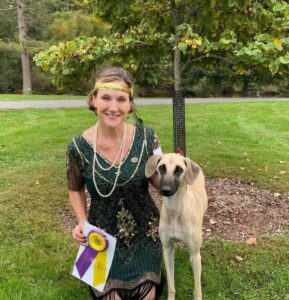
Interview with Hound Group Breeder Nancy Lovelady – Almaboubin Sloughis – My kennel name is Almaboubin which means “beloved” in formal